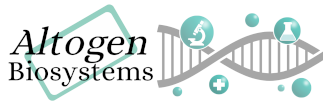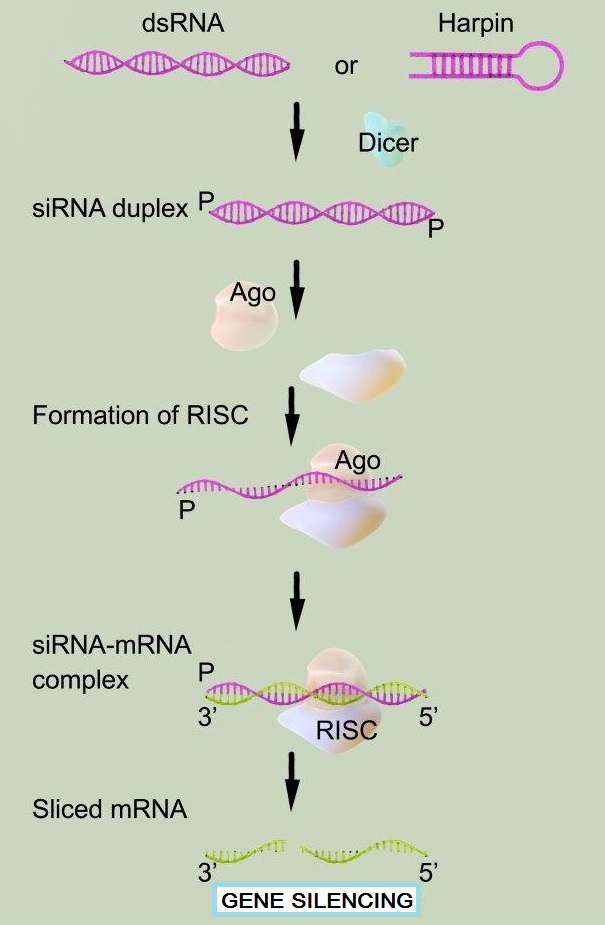Shop Products
siRNA Transfection
siRNA Transfection
Small interfering RNA (siRNA) is a 20-28 nucleotide double stranded RNA (dsRNA) molecule often referred to as “silencing RNA” . siRNA is used in the gene silencing (or RNA Interference, RNAi) technique to suppress gene expression. The main difference between siRNA and microRNA is that siRNAs are not expressed in humans (or other organisms), while microRNAs are exogenously expressed RNAs that regulate eukaryotic gene activity. Laboratory use of RNAi phenomena, along with siRNA-induced gene silencing in mammalian cells, provides a powerful biological research tool for discerning specific gene functions and expression pathways. Gene silencing by siRNA has the therapeutic potential to cure many diseases.
RNAi (RNA interference)
RNAi is a biological mechanism when upon intracellular delivery, the siRNA molecules activate the RNA-Induced Silencing Complex (RISC). Guided by the antisense strand of the siRNA, RISC degrades the target mRNA, thus inhibiting its translation.
Gene Silencing Applications
Gene silencing by RNAi is a powerful research tool for gene expression studies in mammalian cells. This is a biological phenomenon by which small double stranded RNA reduces target gene expression. Inhibition of specific gene expression is experimentally achieved by the transfection of siRNA molecules that bind to the RISC complex and cause degradation of target complementary mRNA molecules in the cell. Successful, potent RNAi experimentation is dependent upon the highly efficient delivery of functional (and non-degraded) siRNA into cells. For mammalian cell transfection – the main factor to consider is cell type. There is no transfection reagent that will work well for all cells – both transfection reagents and associated transfection protocols must be optimized for a specific tumor cell line or primary cell type. Use of non-optimized transfection reagents with standard transfection protocols often results in lack of phenotypic response (due to insufficient transfection efficiency), high cytotoxicity, or both.
Most DNA transfection reagents are incompatible with siRNA, sensitive to serum, or are capable of inducing cytotoxicity, which negatively affects gene expression studies. There are commercially available cell line specific transfection kits that have been developed and optimized specifically for use with siRNA transfection and allow transfection in the presence of serum without lowering transfection efficiency or reducing cell viability (see optimized transfection kits). Ready-to-run transfection protocols eliminate the need for extensive siRNA optimization experiments. Altogen Biosystems kits are also compatible for transfection of microRNA (miRNA) molecules.
Neuronal siRNA Transfection: Gene Silencing in Neurons
A number of studies have demonstrated the successful application of RNAi in primary cell cultures and non-neuronal cell lines; however, the use of gene silencing in neuronal cell types has been notoriously difficult because of several technical and biological limitations. Neurons have been considered the most resistant to RNAi. Methods to consider when performing nucleic acid delivery experiments with neuronal cultures include electroporation, microinjection, viral-based methods, and certain chemical transfection reagents. Although physical delivery methods appear to be efficient for siRNA-induced studies where transient modification of gene expression is sufficient, these methods do not appear to be adequate for behavioral studies where long-term alteration of gene expression may be necessary. The viral-based siRNA expression systems appear to be most applicable for both Central Nervous System (CNS) gene therapy and basic neurobiological studies, while adeno-associated virus (AAV) delivery systems enable long-term, stable gene expression with relatively little cytotoxicity. Lentiviral vectors have been reportedly used successfully for the delivery of short hairpin RNA (shRNA), a precursor of siRNA, into primary neurons to induce RNAi. The advantage of lentiviral systems is the ability to transfect non-dividing cells.
siRNA Medical Potential
Therapeutic techniques based on RNAi technology necessitate the successful introduction of siRNA into an organism’s cells. Although currently there is no one guaranteed approach to do so, modern day research is finding new pathways that can help advance the therapeutic applications of gene silencing. In particular, novel reagents are being developed that can carry siRNA intact to target cells without any immune response or degradation in the blood steam. It should be noted that even though in vitro transfection can be optimized for research applications, the in vivo effects of transfection can be far more consequential – both immune responses and tissue environment can greatly impact the efficiency of compound transfection.
In the future, RNAi therapeutics, driven by the successful introduction of siRNA into patients, could potentially resolve a number of diseases associated with protein overexpression. Many genetic mutations simply lead to an excess production of a protein, and RNAi could help resolve the impacts of such overexpression. In many cases, the proteins themselves are necessary for an organism’s survival, but their production needs to be regulated. Although epigenetic effects may have significant effects on expression, RNAi gene silencing through siRNA transfection could bear revolutionary changes in our approaches to mitigating the impacts of genetic diseases.
What is siRNA Transfection
siRNA transfection is a laboratory technique used to deliver small interfering RNA (siRNA) molecules into cells to silence specific genes or to study gene function. The siRNA molecules are designed to bind to and degrade the messenger RNA (mRNA) of the target gene, resulting in the downregulation or knockdown of gene expression.
siRNA transfection involves the following steps:
- Design of siRNA molecules: The siRNA molecules are designed to target specific sequences of the mRNA of the target gene using bioinformatics tools.
- Selection of transfection method: The siRNA molecules are introduced into cells using a variety of methods, including electroporation, chemical transfection, or viral transduction.
- Optimization of transfection conditions: The conditions for siRNA transfection are optimized to ensure efficient delivery of siRNA molecules into cells while minimizing toxicity and off-target effects.
- Assessment of gene knockdown: The efficiency of siRNA transfection is evaluated by measuring the level of mRNA or protein expression of the target gene using techniques such as quantitative PCR or western blotting.
siRNA transfection is a valuable tool for studying gene function and for developing new therapies for genetic diseases or cancers. However, the efficiency and specificity of siRNA delivery can be affected by various factors, including the choice of siRNA sequence, the type of transfection method, and the cell type being transfected. Therefore, careful optimization of transfection conditions and appropriate controls are important to ensure the reliability and reproducibility of siRNA experiments.
In Vivo Transfection Reagents from Altogen Biosystems
RNAi has been used for in vivo target validation studies using animal models. The major challenge in performing RNAi studies in vivo is the effective, directed delivery of functional small RNA molecules into specific tissues. Altogen® In Vivo Transfection Reagents could be conjugated with siRNA (or microRNA) and administered intratumorally (i.t) or systemically via intravenous (i.v) tail vein injection in order to provide directed gene silencing in specific tissues, including liver, pancreas, kidney, and tumors. Selective knockdown could be seen as early as 24 hours after injection.
Featured in vivo transfection products from Altogen Biosystems:
In Vivo PEG-Liposome Transfection Kit || In Vivo Polymer Transfection Kit || In Vivo Liver-targeted Transfection Kit
Altogen Custom Services provide specialized biotechnology and pharmaceutical services, including over 60 validated xenograft models, development of stable cell lines, RNA Interference (RNAi) services, assay development, ELISA and Western Blot services, siRNA library screening and transfection services. Generation of stably-expressing cell lines can be very expensive and time-consuming. Altogen Labs offers generation of stable cell line service completed in just 28 days (see service details).





